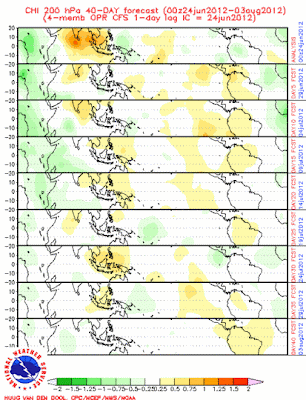This is an analysis of the June 29, 2012 Derecho that hit the Ohio Valley and Mid Atlantic.
The derecho's beginnings were in eastern Iowa, as a complex of thunderstorms that moved eastward into northern Illinois. As the complex moved into Illinois, a shelf cloud was observed, with this being among the many pictures taken.
From Northern Illinois, the complex began a southeast motion and passed through Indiana. As the storms moved into Indiana, they began to strengthen under the influence of more than 5000 j/kg of instability. This development was slightly hindered by the presence of a capping inversion, as noted on the 12z soundings in Indiana.
The cluster began to bow out as it entered central Indiana, as significant instability enhanced the bowing segment to the point of developing a derecho. However, in the early stages, storm reports and radar analysis indicate that hail was present on the western flank of the bowing complex before it switched to a major damaging wind threat.
Moving into the evening, the bowing complex was now a powerhouse derecho, at this time responsible for numerous reports of hurricane strength wind speeds, including a roughly 90 MPH wind gust clocked in Fort Wayne, Indiana. Needless to say, the damage form this derecho only increased as the complex continued on its way. In the evening hours, the storms encountered some fair shearing in the atmosphere, which led to rotating cells. One of them is seen below, at approximately 5:51 PM CDT. At that point in time, the derecho had become comma-shaped, with this tornado-warned cell leading the head of the comma.
Despite the presence of rotating cells, only two unconfirmed tornadoes were reported. Those reports originated from Newcomerstown, Ohio.
Storm reports from the derecho were widespread, with 920 wind damage reports filed into the National Weather Service offices across the Ohio Valley and Mid Atlantic. Notice the slacking off of reports in the Mid Atlantic. That comes as the derecho hit the Appalachian Mountain range, and those mountains did indeed cut down on the power of the system. However, as observed right along the coast, there was still considerable damage from the derecho until the very end.
In summary:
A derecho formed June 29, 2012 in northern Indiana. It then fanned out into a powerful complex of damaging thunderstorms, in which at least 8 people lost their lives. This derecho spanned 600 miles and produced countless wind speeds surpassing 60 MPH. Millions of dollars in damage will likely be used to repair what has been lost.
Andrew
The derecho's beginnings were in eastern Iowa, as a complex of thunderstorms that moved eastward into northern Illinois. As the complex moved into Illinois, a shelf cloud was observed, with this being among the many pictures taken.
From Northern Illinois, the complex began a southeast motion and passed through Indiana. As the storms moved into Indiana, they began to strengthen under the influence of more than 5000 j/kg of instability. This development was slightly hindered by the presence of a capping inversion, as noted on the 12z soundings in Indiana.
The cluster began to bow out as it entered central Indiana, as significant instability enhanced the bowing segment to the point of developing a derecho. However, in the early stages, storm reports and radar analysis indicate that hail was present on the western flank of the bowing complex before it switched to a major damaging wind threat.
Moving into the evening, the bowing complex was now a powerhouse derecho, at this time responsible for numerous reports of hurricane strength wind speeds, including a roughly 90 MPH wind gust clocked in Fort Wayne, Indiana. Needless to say, the damage form this derecho only increased as the complex continued on its way. In the evening hours, the storms encountered some fair shearing in the atmosphere, which led to rotating cells. One of them is seen below, at approximately 5:51 PM CDT. At that point in time, the derecho had become comma-shaped, with this tornado-warned cell leading the head of the comma.
Despite the presence of rotating cells, only two unconfirmed tornadoes were reported. Those reports originated from Newcomerstown, Ohio.
A composite radar image of the derecho shows just how widespread and destructive the complex was, with the strongest cells seen in Ohio. Weakening did occur after the derecho passed through Ohio, but still continued to produce damage into the Mid Atlantic states. The derecho did span roughly 600 miles when it was all set and done, not counting its presence in Iowa and Illinois.
In summary:
A derecho formed June 29, 2012 in northern Indiana. It then fanned out into a powerful complex of damaging thunderstorms, in which at least 8 people lost their lives. This derecho spanned 600 miles and produced countless wind speeds surpassing 60 MPH. Millions of dollars in damage will likely be used to repair what has been lost.
Andrew






























.png)







.png)
.png)



.png)

.gif)




